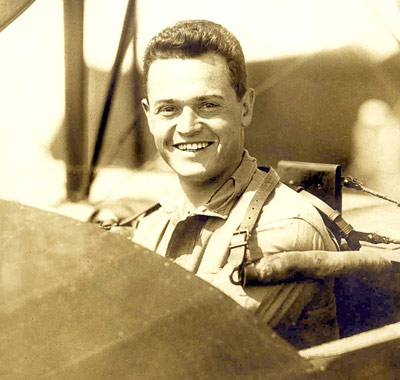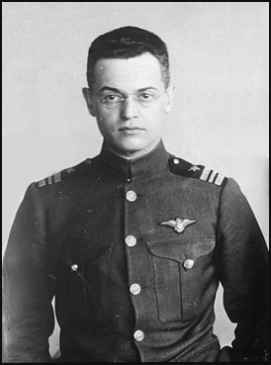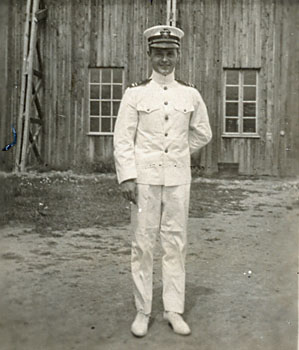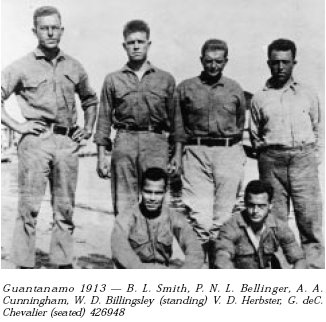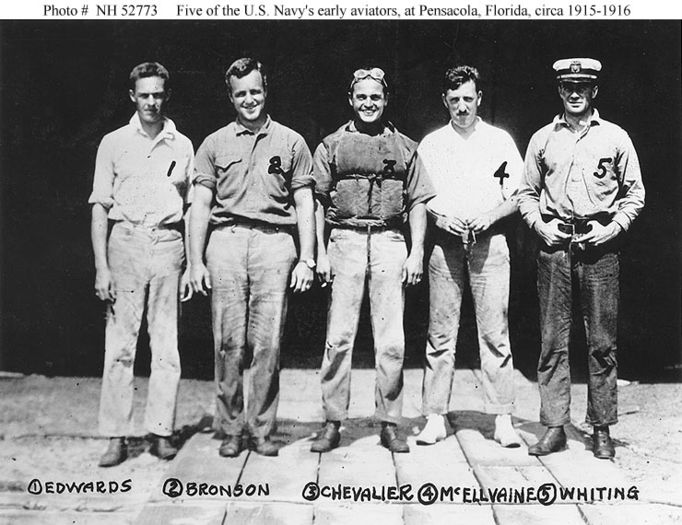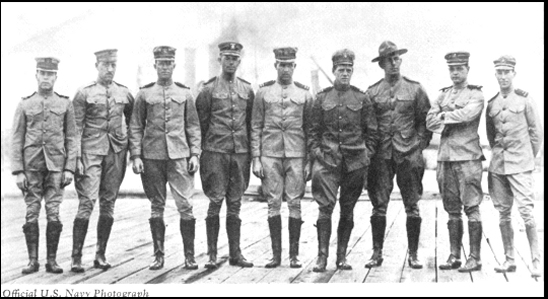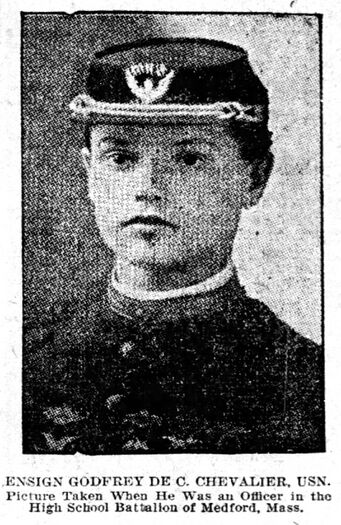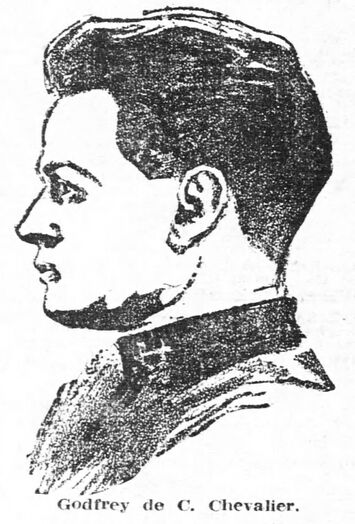GODFREY D. CHEVALIER, LCDR, USN
Godfrey Chevalier '10
Lucky Bag
From the 1910 Lucky Bag:
Godfrey De Courcelles Chevalier
Medford, Massachusetts
"Chevvy" "Darb"
Young Darb is a crack at the mile,
He'll always win out in fine style,
And on the same night
With joy and delight,
On the girls at the hop he will smile.
A CURIOUS mixture of New England Yankee and temperamental Gaul, both of which are eternally fighting for the mastery in his nature. Has all the warm likes and dislikes and the changeability of the Gaul, with the sterner qualities of the Yankee thrown in. Made a very efficient three-striper Plebe summer and was early marked for great things. The victim of the only "hazing" that 1910 suffered; and it is strange that the name then given him—Casey—didn't stick to him. Is quite a track man, and runs the mile in fine shape. A famous fusser, in spite of many Red Mike tendencies. Shines at all the hops and is considered "just too cute." Usually manages to get what he sets out after, and though frequently unsat., always knows when and how to bone, and is still with us in consequence. Has many friends in the yard, but never could be accused of greasing, and would take many D's himself rather than get a classmate one. Is always liked, and readily adapts himself to whatever company he may be in. Will probably make an excellent officer, and you may be very certain that Darb will always make an excellent friend.
Lucky Bag Staff. Track (4, 3, 2, 1). Green 1910. Hop Committee (2, 1). Choir (1). Buzzard (a). Four Buttons (a). Buzzard (b)
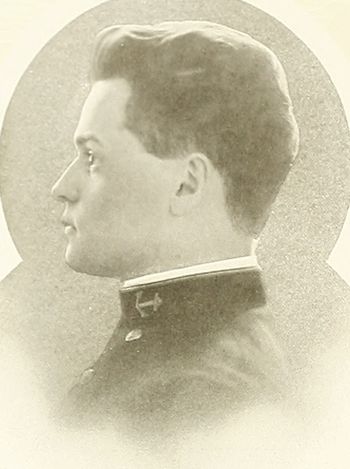
Godfrey De Courcelles Chevalier
Medford, Massachusetts
"Chevvy" "Darb"
Young Darb is a crack at the mile,
He'll always win out in fine style,
And on the same night
With joy and delight,
On the girls at the hop he will smile.
A CURIOUS mixture of New England Yankee and temperamental Gaul, both of which are eternally fighting for the mastery in his nature. Has all the warm likes and dislikes and the changeability of the Gaul, with the sterner qualities of the Yankee thrown in. Made a very efficient three-striper Plebe summer and was early marked for great things. The victim of the only "hazing" that 1910 suffered; and it is strange that the name then given him—Casey—didn't stick to him. Is quite a track man, and runs the mile in fine shape. A famous fusser, in spite of many Red Mike tendencies. Shines at all the hops and is considered "just too cute." Usually manages to get what he sets out after, and though frequently unsat., always knows when and how to bone, and is still with us in consequence. Has many friends in the yard, but never could be accused of greasing, and would take many D's himself rather than get a classmate one. Is always liked, and readily adapts himself to whatever company he may be in. Will probably make an excellent officer, and you may be very certain that Darb will always make an excellent friend.
Lucky Bag Staff. Track (4, 3, 2, 1). Green 1910. Hop Committee (2, 1). Choir (1). Buzzard (a). Four Buttons (a). Buzzard (b)
Loss
Godfrey was lost on November 14, 1922 when he died of injuries sustained two days earlier in a plane crash near Norfolk, Virginia.
Biography
From Destroyer History:
Godfrey de Courcelles Chevalier was born 7 March 1889 at Providence, Rhode Island. When he was young, his family moved to Medford, Massachusetts, where he attended school and was known as “Darb.” A 1910 graduate of the US Naval Academy, he later completed a course in aviation there and then continued as an instructor until 1914. After a year at sea, he reported to the Naval Aeronautics Station at Pensacola, Florida, and was designated Naval Aviator No. 7.
In 1916, while assigned to battleship USS North Carolina, he helped install the first catapult on a naval vessel, and then piloted the first plane to be launched from it.
In 1917, when the United States entered World War I, Chevalier was assigned to duty in Paris, followed by command of the US Naval Aeronautic Station in Dunkerque and the Northern Bombing Squadron, US Naval Aviation Forces in Paris, with intervening assignments in London. For this service he received the Distinguished Service Medal with the following citation: “For exceptionally meritorious service in a duty of great responsibility in connection with the first aeronautical detachment to reach France, and as Commander of the US Naval Air Station at Dunkirk, which was established and maintained in spite of constant bombing by the enemy.”
Following the armistice in November 1918, he served in various posts before participating in the conversion of collier Jupiter as the United States’ first aircraft carrier, USS Langley (CV 1) in 1920. After her commissioning, he served aboard as Officer in Charge of the Aviation Detachment and was credited by Rear Admiral Moffett, Chief of the Bureau of Aeronautics, with developing deck landing gear.
On 17 October 1922, LCdr. Virgil C. (“Squash”) Griffin made the first takeoff from Langley’s deck; on 26 October, LCdr. Chevalier made the first landing—in an Aeromarine 39-B. Less that three weeks later, however, Chevalier incurred multiple injuries in a plane crash near Norfolk and died two days later at the Naval Hospital there.
Admiral Moffett wrote in The Outlook: “Chevalier was one of the most popular and aggressive officers in naval aviation, and his work is largely responsible for the development that has gone forward to date. His death was not only felt as a severe loss in the wealth of experience and knowledge which he possessed; it had a depressing effect on the entire ship’s company, for Chevalier was loved by the men who served under him and by his brother officers.”
From researcher Kathy Franz:
Godfrey was born in Cranston, Providence, Rhode Island. His family later lived at Ogdensburg, New York, and then Medford, Massachusetts.
At MIT in May 1904, Godfrey won the individual championship at the annual interscholastic drill.
On February, 8, 1905, Godfrey was one of eight “dainty maidens” who performed in the musical number “My Little Canoe” at the annual vaudeville show of the Medford boat club.
Godfrey was captain of the Medford high school track team, a star runner, and secretary of the A. A. association. He was also on the high school’s canoe crews.
Per The Boston Globe, November 16, 1922: “He was a track athlete in the days when B. A. A. held interscholastic indoor meets in Mechanics Building. He ran anchor man for Medford High against Brighton High, and after his mates lost much distance Chevalier overcame the lead and beat out the Brighton High final runner at the tape. It was a brilliant achievement. Chevalier made up almost a lap.”
In October, 1906, fourth classman Godfrey was hazed at the Naval Academy by third classman Robert P. Guiler, Jr. Making fun of Godfrey’s name, Guiler called him “God Forsaken” Chevalier. Guiler was given 200 demerits for the hazing, but he did graduate with the Class of 1909.
Shortly after graduating from the Naval Academy, Godfrey was on the New Hampshire. He was in charge of the cutter which was pulling a barge with sailors on board through the Hudson River to the New Hampshire. The sailors had just spent the Saturday evening in New York City. Shore leave had expired at 7 p.m., and about 80 to 90 men were waiting at the wharf laughing and singing.
Per The Columbia Record, October 4, 1910: Godfrey said, “It seems as if I always have been in trouble . . . There was a hazing matter at Annapolis in my plebe year when everybody in the upper classes thought I had peached on the upper classmen. Other things followed one another so that I thought I was hoodooed for fair. Then for a while it seemed as if I had a little luck. Things were going well, but two months ago at Provincetown, Mass., my old bad luck turned up again. I was out in a cutter and we nearly collided with another boat as we rounded the prow of the battleship. I saw that the other craft was likely to take off our rudder, so I reached out with my hand to fend her off. The result was that my hand was crushed and it was only taken out of plaster cast a few days ago. Then came the awful affair of Saturday night. That is too horrible for me to talk about.”
Per the St Louis Post-Dispatch: Godfrey is accredited with having saved 20 men. . . . He is only 20 years old, a tall, lithe, curly-haired youth, brown faced, with regular features and a clear eye.
At noon Sunday his mother came aboard the New Hampshire. He turned and saw her, started and gulped an instant and then put his arms around her neck and sobbed.
“Mother—oh, mother,” he said, “it is terrible. I can’t--can’t stop seeing it and hearing it. I feel as though in some way I’m to blame, and yet I know I’m not.” . . .
Seaman J. M. McMaine said, “The boys were pretty careless about keeping any balance to their boat, and two or three times George Stewart, coxswain of the sailing launch, spoke to them and told them to keep back from the bow. What caused the accident was the quick turn the cutter took to readjust herself and get straight ahead of her bow. The cutter being a lighter boat and with only six men aboard, was being carried up the river by the tide, whereas the launch with its heavy load, kept straight on her course. Coxswain Setley at the wheel of the cutter, veered her over sharply just as we had ridden over a pretty big wave.
“The tow line tautened on the launch, dragging her sharply to port just as she was tossed up on the summit of the wave we had just passed. She came over the wave with a lurch; the men standing crowded in the bow were thrown forward. All this weight suddenly put on the bow, she went under and the men were toppled into the water.
“I knew lots of the fellows couldn’t swim. I made out three men and threw out a life buoy toward them and threw off the painter to prevent the cutter being dragged under with the launch. I ran back to the bow and saw that the buoy that I had thrown to the three fellows I had made out had not reached them. I stripped in a hurry and jumped into the water, swam to the buoy and pushed it out to the fellows.
“As I turned back I made out another man struggling near me. I caught him by the collar and brought him to the cutter’s stern, and he grabbed on tight all right. Then I climbed back in the cutter. I leaned over the side grappling wherever I heard a sound and caught two other men that way.
“Two or three times I caught sight of Chevalier. You never saw anybody work the way he did. Every time I looked around it seemed it was to see him bringing a new man alongside to safety, sometimes to the cutter and sometimes to the civilian boats that came shooting along from all directions.
“Chevalier was aboard the cutter as our boat came alongside, he was limp and panting. He tried to speak two or three times, but he didn’t have breath to do it. When he was able to talk, Chevalier said he hoped that all the men had been saved but when he was told that many of the boys had gone under, he brought his hands up as if he were going to dive. We caught him and wouldn’t let him jump.
“He went wild then. He yelled: ‘Let me go—let me go, I tell you.’ And he tried to fight but he was so weak he could hardly struggle at all. Then he fell back in the boat shivering and began to cry.”
The disaster took 29 lives.
In March, 1911, while the New Hampshire was in a dry dock at the Brooklyn Navy Yard, Godfrey saved the ship from a costly accident. He was in the engine room when he noticed water rushing into the fireroom. He and the chief machinist crawled on hands and knees to a valve which was out of order. He grabbed a bucket of red lead and quickly plastered and stopped the leak. Later 14 other similar valves were found leaking.
In late 1912, Godfrey was studying aviation at the Naval Academy. In December, he and others were sent to the Cumberland at the Guantanamo Naval Station. He won considerable renown during his flights over Cuban waters. On March 10, 1913, Godfrey and Lieutenant John H. Towers (‘06) made a record 45-mile flight from Guantanamo to Santiago in 46 minutes in a 15-mile wind. The next day they returned against a 20-mile wind in one hour and 17 minutes.
On May, 9, 1913, Godfrey and Lieutenant John H. Towers flew from the Washington Navy Yard to Annapolis in a Curtiss flying boat. The trip of 169 miles was made in three hours and five minutes with an average speed of 56 miles per hour.
In July 1913 Godfrey was one of the pilots who were the first to fly after William D. Billingsley (‘09) had died falling from a “flying boat” in Chesapeake Bay.
In early October that year, Godfrey was arrested for joy riding in Baltimore. Reports indicated that his automobile ran into two small boys.
In January 1914 Godfrey was a guest at the New Year’s german of the Bachelor’s Cotillon Club in Baltimore.
In July 1915 he was on duty at the Burgess factory at Marblehead, Massachusetts, inspecting and supervising work for the Navy’s aviation arm on aeroplanes.
In March 1917 Godfrey was reported missing somewhere off Cuba on a scouting flight. Godfrey had recently been transferred from the North Carolina to the Seattle. He returned several days later saying the plane had machinery trouble, and he was obliged to land in a remote section. He was picked up by a torpedo boat.
In May that same year, he was sent to France. He commanded Naval stations at Dunkirk and Ensleigh, England. For a time, he was attached to the Grand Fleet in the North Sea, studying British Naval aviation.
In June 1917 Godfrey became engaged to Marguerite Jackson of Chicago, a girl he had met at the Naval Academy. They married on June 14, 1919, in Baltimore. Their son Godfrey, Jr., was born in 1920.
In June 1919 in Washington, D. C., Godfrey was decorated with the cross of the Chevalier of the Legion by the French Government for distinguished service during World War I. He was also awarded the Croix de Guerre with palm and the Distinguished Service medal.
In the March 1920 census, Godfrey was at sea on the USS Pennsylvania.
In October 1922 Godfrey was the first aviator to land on the airplane carrier Langley. He was flying a two-seater, 4-606. He landed at a velocity of 45 knots and was stopped by the arresting gear within 25 feet. The Langley was proceeding at a speed of about six knots, and a 30-mile wind was blowing from the northwest.
Per The Boston Globe, November 13, 1922: Godfrey’s plane seemed to encounter trouble with the steering gear. After swooping about in an attempt to effect a landing, the machine crashed into the marsh, and he was pinned under the wreckage. He was saluting friends as he fell. His wife was on her way from Washington to his bedside when she was involved in a forced landing in Chesapeake Bay. He died the next day of his internal injuries.
His father Charles was a railroad official for the Grand Trunk, the old New York & New England, and the Boston & Maine railroads. His mother was Elizabeth, and his sisters were Constance and Marguerite (Mrs. Nelson W. Howard of Ogdensburg.)
Godfrey had four brothers. Charles Grosvenor was a general storekeeper of the Maryland Steel Company in 1906, and he worked for the fire brick company in 1920. Brother Edward, known as “Ted,” was born in 1875, and as a young man, he accompanied his father to work on the railroad in Nicaragua. Ted died and was buried there. Brother Elmer was born in 1877 and was a surveyor for the Army’s 21st Infantry, Company E. He died of pneumonia on board the US Hancock on April 26, 1899, and was buried at sea. Brother John Bayard Chevalier was named alternate to the Naval Academy in April, 1903. He was in Supply companies of the Army infantries from 1914 through 1917, and he was in Shanghai, China, in 1915.
Godfrey was one of the men to establish NAS Pensacola, Florida; he flew one of the first two seaplanes from that base.
Godfrey was survived by his wife and son; he is buried in Arlington National Cemetery.
Photographs
Left to right: Lieutenant V. D. Herbster, Lieutenant W. M. McIlvain, Lieutenant P. N. L. Bellinger, Lieutenant Richard Saufley '08, Lieutenant J. H. Towers, Lieutenant Commander H. C. Mustin, Lieutenant (Army) B. L. Smith, Ensign Godfrey Chevalier '10, and Ensign Melvin Stolz '10.
From Hall of Valor:
The President of the United States of America takes pleasure in presenting the Navy Distinguished Service Medal to Lieutenant Commander Godfrey DeCourcelles Chevalier, United States Navy, for exceptionally meritorious service in a duty of great responsibility in connection with the first aeronautical detachment to reach France, and as Commander of the United States Naval Air Station at Dunkirk, which was established and maintained in spite of constant bombing by the enemy. Later he commanded the assembly and repair base at Eastleigh, England.
General Orders: Authority: Navy Book of Distinguished Service (Stringer)
Service: Navy
Division: United States Naval Air Station at Dunkirk, France
Related Articles
Richard Saufley '08, Melvin Stolz '10, and Clarence Bronson '10, were also pictured among the Navy's earliest aviators.
The "Register of Commissioned and Warrant Officers of the United States Navy and Marine Corps" was published annually from 1815 through at least the 1970s; it provided rank, command or station, and occasionally billet until the beginning of World War II when command/station was no longer included. Scanned copies were reviewed and data entered from the mid-1840s through 1922, when more-frequent Navy Directories were available.
The Navy Directory was a publication that provided information on the command, billet, and rank of every active and retired naval officer. Single editions have been found online from January 1915 and March 1918, and then from three to six editions per year from 1923 through 1940; the final edition is from April 1941.
The entries in both series of documents are sometimes cryptic and confusing. They are often inconsistent, even within an edition, with the name of commands; this is especially true for aviation squadrons in the 1920s and early 1930s.
Alumni listed at the same command may or may not have had significant interactions; they could have shared a stateroom or workspace, stood many hours of watch together, or, especially at the larger commands, they might not have known each other at all. The information provides the opportunity to draw connections that are otherwise invisible, though, and gives a fuller view of the professional experiences of these alumni in Memorial Hall.
January 1911
January 1913
January 1914
January 1915
January 1916
January 1917
March 1918
January 1919
January 1920
January 1921
January 1922
Namesakes
USS Chevalier (DD 451) and USS Chevalier (DD 805) were named for Godfrey; the ships were both sponsored by his widow.
Chevalier Field was also named for him.

The "category" links below lead to lists of related Honorees; use them to explore further the service and sacrifice of alumni in Memorial Hall.
